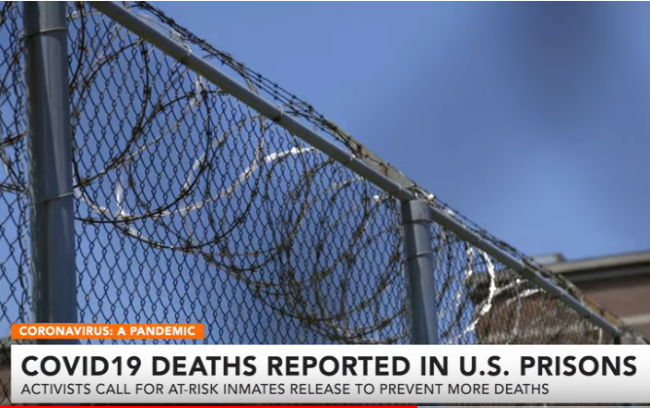[COVID-19\Incarceration]
Nadler & Bass: “We urge that you use every tool at your disposal to release as many prisoners as possible, to protect them from COVID-19.”
Photo: YouTube
Rep. Karen Bass and Rep Jerrold Nadler have sent a letter to Attorney General Barr regarding the critical COVID-19 situation inside America’s prisons.
House Judiciary Subcommittee on Crime Chairwoman Karen Bass (D-Calif.) and House Judiciary Committee Chairman Jerrold Nadler (D-New York) sent a letter to U.S. Attorney General William Barr urging him to use the authority granted under the Coronavirus Aid, Relief, and Economic Security Act (CARES Act) to protect the most vulnerable prisoners and those working in federal prisons from coronavirus (or COVID-19).
The full text of the letter is available below.
Dear Attorney General Barr:
On the evening of March 28, 2020, we sadly learned of the first death of a prisoner in the custody of the federal Bureau of Prisons (BOP) due to COVID-19.[1] The decedent was a 49-year-old African-American man who, according to the BOP’s press release announcing his death, had “long-term, pre-existing medical conditions which the CDC (Centers for Disease Control and Prevention) lists as risk factors for developing more severe COVID-19 disease.”[2] He was housed in a low-security facility in Oakdale, Louisiana.[3] Reports now indicate that one guard at the same facility is in intensive care due to COVID-19 and there have been positive test results for another 30 prisoners and staff.[4] This death and the explosion of cases in the Oakdale prison underscore the urgency of taking action to prevent more avoidable deaths of individuals in federal custody.
The Department of Justice (DOJ) and BOP presently have the authority to request, under 18 U.S.C. § 3582(c)(1)(A)(i), that courts modify the sentences of prisoners who present “extraordinary and compelling reasons.”[5] We call on you, in the most urgent of terms, to do the right thing and exercise this authority and immediately move to release medically-compromised, elderly, and pregnant prisoners in the custody of the BOP.
In addition, we urge that you use every tool at your disposal to release as many prisoners as possible, to protect them from COVID-19. Along those lines, and as you move forward with planning for and executing the release of what we hope will be an appropriately sizable number of BOP prisoners, we urge you to consider the issues raised below.
Home Confinement Release Authority Under the CARES Act
On March 27, 2020, the House passed, and President Trump signed into law, the Coronavirus Aid, Relief, and Economic Security Act,” or the “CARES Act.”[6] Among other things, the CARES Act broadens the authority of the Attorney General and the Director of the BOP, during the COVID-19 crisis, to release prisoners to home confinement.[7] We ask that both you and the Director of the BOP interpret and exercise this new authority as broadly as possible, given that thousands of lives are at stake.
As you know, before BOP can exercise its authority under the CARES Act, the Attorney General must make a finding that “emergency conditions will materially affect the functioning of the Bureau [of Prisons].”[8] On March 26, 2020, you issued a memorandum directing the BOP to prioritize home confinement as an appropriate response to the COVID-19 pandemic.[9] Your memorandum certainly implies that the COVID-19 pandemic is “materially affect[ing] the functioning” of BOP.[10] Your memorandum further urges the Director of the BOP to “prioritize the use of [his] various statutory authorities for inmates seeking transfer in connection with the ongoing COVID-19 pandemic.”[11] In order for the Director of the BOP to exercise his statutory authority under the CARES Act, the Attorney General must first find that COVID-19 is materially affecting the functioning of the BOP. We urge you to make this finding immediately.
Memorandum of March 26, 2020
Although we were encouraged to see that you have already issued a directive to the Director of the BOP prioritizing home confinement as appropriate in response to the COVID-19 pandemic, your memorandum raises a number of concerns:
(1) Public Health. We are troubled by your statement that “[m]any inmates will be safer in BOP facilities where the population is controlled and there is ready access to doctors and medical care.”[12] While that may well be the case for some inmates, we hope this statement does not indicate that you believe that prison is a safe place for anyone to be during a pandemic. Quite the contrary, as already demonstrated by the death of a medically-compromised BOP prisoner and the growing numbers of infected persons in BOP facilities across the country.[13] For instance, we are not aware that BOP facilities, as a whole, have “ready access to doctors”; a 2019 report by DOJ’s Office of the Inspector General found that “staffing prisoners with qualified healthcare workers is a challenge for the BOP.”[14] This is likely even more true at the present time, with large numbers of healthcare workers being deployed to battle COVID-19 outside the prison walls. In addition, the CDC have encouraged “social distancing” and increased hygiene to prevent COVID-19.[15] Unfortunately, many BOP facilities utilize close-quarter housing,[16] which makes it impossible to accomplish adequate distancing between prisoners. And, it is no secret that hygienic conditions are lacking in BOP facilities,[17] as they are in prisons across the country. For all these reasons, the best way to ensure that our prisons do not become epicenters of this incredibly virulent, contagious, and deadly disease is to release as many people as possible.
(2) Criteria for Home Confinement Assessment. The criteria you set forth for BOP to utilize in prioritizing who should be placed in home confinement during the COVID-19 pandemic, although discretionary, will likely preclude the expeditious release of many prisoners who should be released. The following criteria are especially problematic and raise some questions:
(a) Use of PATTERN.[18] Although BOP has begun to use PATTERN, the tool developed pursuant to the First Step Act to assess inmates with regards to their recidivism risk, it is still an incomplete tool; it has yet to be independently validated, as required by the First Step Act.[19] Indeed, many questions remain about PATTERN’s validity because of possible racial/ethnic and gender bias and because of the tool’s overemphasis on static factors such as criminal history. Moreover, as you know, PATTERN was created for an entirely different purpose than for assessing whether prisoners should be released during a pandemic. For these reasons, we urge BOP not to use a prisoner’s PATTERN score as a consideration for whether they should be released to home confinement during the COVID-19 pandemic.
(b) Re-Entry Plan. One of the criteria you set forth is that the inmate have a “demonstrated and verifiable re-entry plan that will prevent recidivism and maximize public safety.”[20] How will you measure whether a plan prevents recidivism and maximizes public safety? Will you be providing guidance on how the BOP Director is to make this assessment? If so, what are the parameters? How will you ensure that meeting this criterion is not unduly burdensome for inmates, especially those who are elderly or medically-compromised? We also note that this criterion (i.e., having a proper reentry plan) appears to apply to individuals who are already in the “pipeline” for release. We note this to urge that you do not restrict the home confinement prioritization only to individuals who are already “seeking” transfer. There will certainly be individuals who would be newly eligible after the CARES Act, but who may not be aware they are eligible and, for that reason, are not yet seeking transfer to home confinement. Due to the enactment of the CARES Act, we urge you to proactively direct the BOP to identify all individuals who would be eligible for release to home confinement under the newly expanded statutory authority, notify them that they are eligible, and assess them for release. Please advise whether you intend to do this.
(c) Prioritization of Low and Minimum Security Facilities and Discouragement of Release for Inmates with Serious Offenses. Your memorandum specifies that priority should be given to inmates in low- and minimum-security facilities and that “serious” offenses should weigh more heavily against consideration for home detention.[21] These limitations, unfortunately, beg the question of what you do with individuals who are at a high risk for contracting COVID-19 who are not in low- or minimum-security facilities, who have been convicted of serious offenses, or who have high PATTERN risk scores. We urge you to consider that even individuals in these categories should be assessed for release because they may be elderly or particularly vulnerable.[22] Pregnant prisoners, in all circumstances, should be released to home confinement forthwith. We further urge you to assess the risk of contracting COVID-19 of every individual in BOP custody, regardless of the type of institution in which they are housed, the seriousness of their offense, or the potential recidivism risk they may present. If BOP decides to keep these individuals detained, what specific provisions are being made for those among them who are at high risk for contracting COVID-19? What plans are being made to communicate information to these individuals, their attorneys, and their loved ones, about the plan for their care behind bars during the COVID-19 pandemic?
(3) Location Monitoring. Your memorandum states that any individuals released because of the COVID-19 pandemic will be released with location monitoring.[23] If this is the case, we ask that you ensure that there are enough resources to provide monitoring equipment free of charge to those individuals released and that you ensure that there is enough equipment available, so that no one is kept behind bars because of a lack of availability of equipment. Please confirm whether it is your intent to ensure this and, if not, why not.
Full Utilization of Second Chance Act Elderly Home Confinement Program
You should also exercise your authority to release as many people as possible into home confinement, under the elderly home confinement pilot program established under the Second Chance Act.[24] The elderly home confinement program authorizes you to waive the requirements of section 3624 of title 18, “as necessary to provide for the release of some or all eligible elderly offenders and eligible terminally ill offenders from Bureau of Prisons facilities to home detention.”[25] In other words, the statute authorizes, and indeed it encourages, you to place all eligible elderly offenders in the pilot program—without regard for any of the time constraints set forth in section 3624. Current conditions underscore the need to exercise this authority fully. Please advise us whether you will seek to do so.
Residential Reentry Centers
We want to highlight an issue that has been brought to our attention regarding persons who are currently finishing out their BOP sentences in residential reentry centers. Under the CARES Act, you have been granted authority, if you choose to exercise it, to release to home confinement every person who is currently finishing out his or her sentence in a residential reentry center. In particular, if they have been released to a residential reentry center and have been there without incident, you should, at a minimum, consider these individuals to have a “lower risk level.” We have been dismayed to hear, in the last few days, several stories of elderly and vulnerable inmates who are residing in close-quarters in residential reentry centers and are fearful of getting sick. If they otherwise qualify, these individuals should be allowed to be placed on home confinement under the CARES Act. We urge you to pay particular attention to this issue, and to inform us whether these individuals have been released or whether they will be considered for release pursuant to the new authority granted under the CARES Act and, if not, why not.
Movement of Prisoners from Facility to Facility
We are familiar with BOP’s directive suspending internal movement during the COVID-19 pandemic, with limited exceptions—among these are, transportation for forensic testing and treatment and movements to ameliorate overcrowding in certain facilities. Unfortunately, I have heard multiple reports that BOP is transporting prisoners outside of the limited exceptions BOP has enumerated. Please confirm whether all BOP facilities are complying with the directive to suspend internal movements during the COVID-19 pandemic. We are also deeply troubled by the fact that those being moved are merely being given exit “screenings.” As you know, carriers of COVID-19 can be completely asymptomatic. If BOP is going to continue moving prisoners from facility to facility it must test—not merely screen—prisoners prior to moving them, else there is a high risk of transmission among facilities. We understand that BOP’s Emergency Operations Center is tracking and monitoring prisoner movement during this time. Please provide us with the information you are collecting about prisoner movements, explaining what factors necessitated the movement.
Data-Gathering and Reporting
We also ask that you collect and maintain comprehensive data about the release of inmates into home confinement in response to the COVID-19 pandemic for the purpose of reporting the information to Congress. Specifically, we ask that you gather data pertaining to every inmate in BOP and whether they were considered for release and if not, why not. With regards to those who were considered for release, but were ultimately not released, please provide an explanation for why they were not released. Please ensure that this data is collected and organized in a way that it can be searched in relation to demographic factors, such as age, race and ethnicity, and gender. Finally, it goes without saying that we are deeply concerned about what is going on in BOP facilities around the country during this pandemic, especially now that a federal prisoner has died from COVID-19 and reports of increasing numbers of infected prisoners and correctional officers. In the coming weeks, we hope you will institute aggressive measures to release medically-compromised, elderly and pregnant prisoners, as well as universal testing in BOP facilities–to protect everyone. As we have told you before, we are ready to work with you to address the needs of prisoners during this difficult time. We appreciated your response to our earlier letters on the topic of COVID-19. We look forward to receiving your response to this letter in the same prompt manner. Urgent action is required because lives depend on it.
Sincerely,
Jerrold Nadler, Chairman Karen Bass, Chair of the Subcommittee on Crime, Terrorism, and Homeland Security





